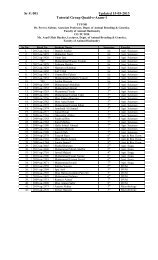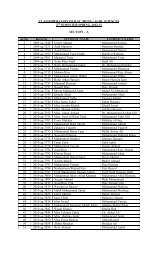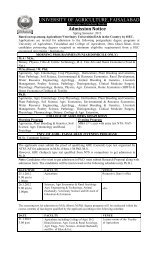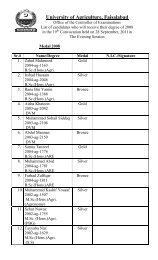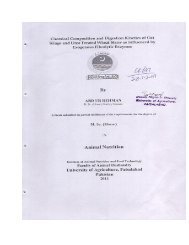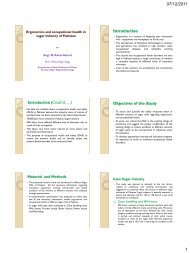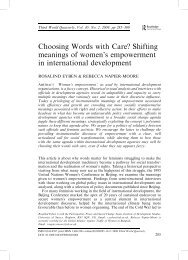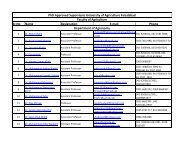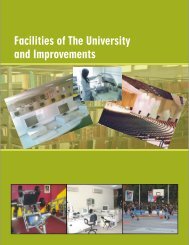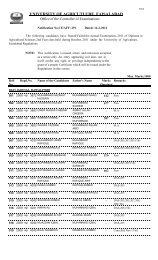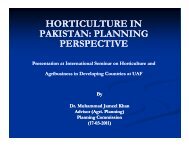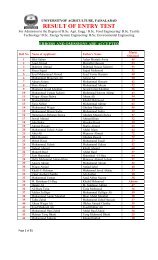Isolation and identification of soil mycoflora with special reference to ...
Isolation and identification of soil mycoflora with special reference to ...
Isolation and identification of soil mycoflora with special reference to ...
Create successful ePaper yourself
Turn your PDF publications into a flip-book with our unique Google optimized e-Paper software.
“<strong>Isolation</strong> <strong>and</strong> <strong>identification</strong> <strong>of</strong> Soil myc<strong>of</strong>lora <strong>with</strong><br />
<strong>special</strong> <strong>reference</strong> <strong>to</strong> Cera<strong>to</strong>cystis fimbriata in<br />
decline affected mango orchards <strong>of</strong> Multan,<br />
Pakistan”<br />
1<br />
Asif Mahmood Arif, 1 Munawar Raza Kazmi, 1 Faisal Sohail Fateh,<br />
1<br />
Iftikhar Ahmad, 2 Inam-ul-Haq<br />
1<br />
National Agricultural Research Centre, Islamabad,<br />
2<br />
Univeristy <strong>of</strong> Arid Agriculture Rawalpindi.
Contents<br />
‣ Introduction<br />
‣ Objective<br />
‣ Materials <strong>and</strong> methods<br />
‣ Results <strong>and</strong> discussions<br />
‣ Conclusion<br />
‣ Way forward
INTRODUCTION<br />
Mango<br />
Mango (Mangifera indica L.) is the most popular<br />
fruit due <strong>to</strong> its taste <strong>and</strong> nutritional contents. It<br />
belongs <strong>to</strong> the family Anacardiaceae.<br />
In Pakistan, mango st<strong>and</strong>s second in area <strong>and</strong><br />
production after citrus.
Mango is grown on area <strong>of</strong> 198380 hec. <strong>with</strong><br />
production <strong>of</strong> 1845528 <strong>to</strong>nnes.<br />
Mango as foreign exchange earning crop.<br />
It contributes 24% <strong>to</strong> GDP.<br />
Only mango export is 1,27,000 <strong>to</strong>nnes <strong>with</strong><br />
a value <strong>of</strong> 6.2 million US dollars in 2009-10
Mango Sudden Death<br />
Common<br />
Diseases<br />
Malformation<br />
Powdery Mildew<br />
Anthracnose
• Among several diseases, mango decline is the most<br />
important malady.<br />
• The symp<strong>to</strong>ms <strong>of</strong> decline are leaf drooping, bark<br />
splitting, stem canker <strong>and</strong> stem gummosis
Objectives<br />
‣ To have inven<strong>to</strong>ry <strong>of</strong> <strong>soil</strong> myc<strong>of</strong>lora <strong>of</strong> mango orchards in<br />
Multan in general.<br />
‣ To check the presence <strong>of</strong> cera<strong>to</strong>cystis fimbriata in <strong>soil</strong> <strong>of</strong> the<br />
orchards in particular.<br />
‣ To check the role <strong>of</strong> cera<strong>to</strong>cystis fimbriata for causing<br />
mortality alone.
MATERIALS AND METHODS<br />
Survey &<br />
Sampling:<br />
N<br />
Disrtict Surveyed<br />
Multan<br />
SINDH<br />
INDIA<br />
30 o 00 N, 70 o 00 E
‣ <strong>Isolation</strong><br />
Serial Soil dilution method.<br />
‣ Identification<br />
The <strong>identification</strong> was made on the basis <strong>of</strong> morphological characters<br />
(colony characteristics, mycelial growth <strong>and</strong> presence <strong>of</strong> conidia).<br />
‣ Determination <strong>of</strong> Fungal Frequencies<br />
Frequency (%) = No. <strong>of</strong> colonies <strong>of</strong> a particular fungus 100<br />
Total no. <strong>of</strong> colonies
RESULTS AND DISCUSSIONS<br />
Fig. 1. Fungal frequency (%) isolated from <strong>soil</strong> <strong>of</strong> decline affected mango orchards<br />
C. fimbriata 62.66%, F. solani 20%, B. theobromae 12%,<br />
Alternaria alternata 2.66% , Aspergillus Sp. 2.66% .
Fig. A. Conidia <strong>and</strong> conidiophores<br />
<strong>of</strong> C. fimbriata<br />
Fig. B Botryodiplodia theobromae
Fig. C. Fusarium solani<br />
Fig. D. Alternaria alternata
Soil drenching method<br />
Pathogenicity test
Pathogenicity Results<br />
(Injured Roots)<br />
S. No Fungi Symp<strong>to</strong>ms<br />
1 C. fimbriata Leaf drooping, bark splitting, stem canker, stem<br />
gummosis<br />
2 B. theobromae Leaf drooping<br />
3 F. solani Leaf drooping & bark splitting<br />
4 C. fimbriata+B. theobromae Leaf drooping, Bark splitting <strong>and</strong> stem canker<br />
5 C. fimbriata+ F. solani Leaf drooping, Bark splitting <strong>and</strong> stem canker<br />
6 B. theobromae+ F. solani Leaf drooping & bark splitting<br />
7 C. fimbriata+B. theobromae+ F. solani Leaf drooping, bark splitting, stem canker, stem<br />
gummosis
Pathogenicity Results<br />
(Non-injured Roots)<br />
S. No Isolated Fungi Symp<strong>to</strong>ms<br />
1 C. fimbriata Salt injury, gummosis<br />
2 B. theobromae No Symp<strong>to</strong>ms<br />
3 F. solani Stem gummosis<br />
4 C. fimbriata+B. theobromae Salt injury<br />
5 C. fimbriata+ F. solani Gummosis<br />
6 B. theobromae+ F. solani No symp<strong>to</strong>ms<br />
7 C. fimbriata+B. theobromae+ F. solani Gummosis
‣ Re-isolation<br />
Except B. theobromae the fungus C. fimbriata <strong>and</strong> F. solani were reisolated<br />
from the diseased mango plants. Hence, proved the association <strong>of</strong><br />
C. fimbriata alone <strong>and</strong> <strong>with</strong> combination <strong>to</strong> F. solani in mango decline<br />
disease.
Conclusion<br />
This study proved that fungus C. fimbriata<br />
remains in the <strong>soil</strong> <strong>and</strong> on injury it enter<br />
through the wounds <strong>and</strong> cause decline.
Way Forward<br />
‣Adoption <strong>of</strong> high efficiency irrigation system.<br />
‣Need <strong>to</strong> increase fertility <strong>of</strong> <strong>soil</strong>.
ACKNOWLEGEMENTS<br />
This part <strong>of</strong> study was done under ASLP Mango Project<br />
“Development <strong>of</strong> integrated crop management practices <strong>to</strong><br />
increase sustainable yield <strong>and</strong> quality <strong>of</strong> mangoes in Pakistan<br />
<strong>and</strong> Australia” funded by Aus-Aid through ACIAR Govt. <strong>of</strong><br />
Australia.
QUESTIONS<br />
???



